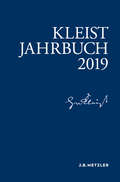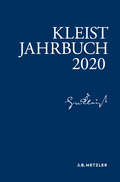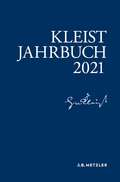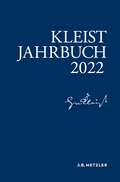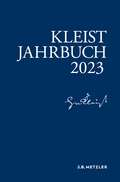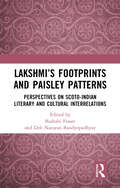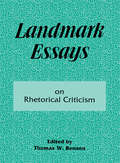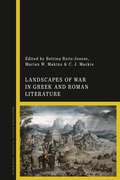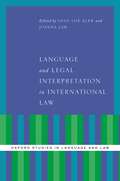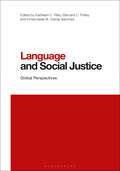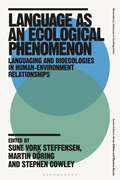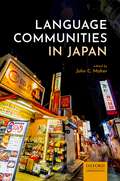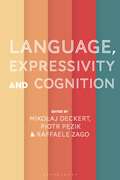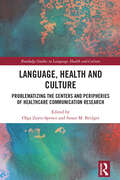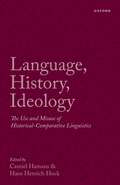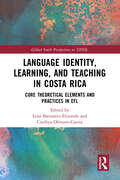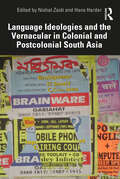- Table View
- List View
Kleist-Jahrbuch 2018 (Kleist-Jahrbuch)
Das Kleist-Jahrbuch 2018 dokumentiert die Verleihung des Kleist-Preises 2017 mit den Reden des Preisträgers Ralf Rothmann, der Vertrauensperson der Jury Hanns Zischler und des Präsidenten der Heinrich-von-Kleist-Gesellschaft Günter Blamberger. Es beinhaltet weiterhin Beiträge der interdisziplinären Konferenz „Heillose Menschen? Religiöse Implikationen in Kleists Werken“ (u.a. von Hans-Richard Brittnacher, Andrea Polaschegg, Ulrike Vedder) und des Studientages „Kleists 'Michael Kohlhaas' polyperspektivisch“. Rezensionen, Miszellen sowie die neue Rubrik Übersetzungen beschließen den Band.
Kleist-Jahrbuch 2019 (Kleist-Jahrbuch)
Das Kleist-Jahrbuch 2019 dokumentiert die Verleihung des Kleist-Preises 2018 mit den Reden des Preisträgers Christoph Ransmayr, der Vertrauensperson der Jury László Földényi und des Präsidenten der Heinrich-von-Kleist-Gesellschaft Günter Blamberger. Den Schwerpunkt bilden die von Anne Fleig betreuten Beiträge der internationalen Jahrestagung der Heinrich-von-Kleist-Gesellschaft (in Kooperation mit der Deutschen Schillergesellschaft) ›Kleist und Schiller - Auftritt der Moderne‹ (u.a. von Peter-André Alt, Claudia Benthien, Christian Moser und Dorothea von Mücke) und die von Matthias N. Lorenz und Thomas Nehrlich geleitete Tagung ›Kleists Anekdoten – Zur Größe der Kleinen Formen‹ im Kleist-Museum, Frankfurt (Oder). Rezensionen und Miszellen beschließen den Band.
Kleist-Jahrbuch 2020 (Kleist-Jahrbuch)
Das Kleist-Jahrbuch 2020 dokumentiert die Verleihung des Kleist-Preises 2019 mit den Reden der Preisträgerin Ilma Rakusa, der Vertrauensperson der Jury Yoko Tawada und des Präsidenten der Heinrich-von-Kleist-Gesellschaft Günter Blamberger. Abhandlungen zu Kleists Werken, Miszellen zum Umfeld Kleists, Nachrufe auf Hans Joachim Kreutzer und Alexander Weigel sowie Rezensionen wissenschaftlicher Neuerscheinungen zu Kleist beschließen den Band.
Kleist-Jahrbuch 2021 (Kleist-Jahrbuch)
Das Kleist-Jahrbuch 2021 enthält neben Beiträgen zur ›Politik des Rechts im Werk Heinrich von Kleists‹ von Bernd Fischer, Antonia Eder, David Pan, Bernhard Greiner, Johannes F. Lehmann, Tim Mehigan und Christian Moser weitere Abhandlungen von Rüdiger Görner, Andreas Moser, Patrick Fortmann und Tobias Krüger. Rezensionen wissenschaftlicher Neuerscheinungen beschließen den Band.
Kleist-Jahrbuch 2022 (Kleist-Jahrbuch)
Das Kleist-Jahrbuch 2022 dokumentiert die Verleihung des Kleist-Preises 2020 im November 2021 mit den Reden des Preisträgers Clemens J. Setz, der Vertrauensperson der Jury Daniela Strigl und des Präsidenten der Heinrich-von-Kleist-Gesellschaft Günter Blamberger. Den Schwerpunkt bilden die von Andrea Allerkamp und Martin Roussel betreuten Beiträge der internationalen Jahrestagung der Heinrich-von-Kleist-Gesellschaft 2021 ›Um einen Kleist von außen bittend‹ (u.a. von László F. Földényi, Rüdiger Görner, Andrea Pagni, Paul Michael Lützeler und Carlotta von Maltzan). Abhandlungen zu Kleists Werken und Rezensionen wissenschaftlicher Neuerscheinungen zu Kleist sowie zu seinen historischen und systematischen Kontexten beschließen den Band.
Kleist-Jahrbuch 2023 (Kleist-Jahrbuch)
Das Kleist-Jahrbuch 2023 dokumentiert die Verleihung des Kleist-Preises 2022 im November 2022 mit den Reden der Preisträgerin Esther Kinsky, der Vertrauensperson der Jury Paul Ingendaay und der Präsidentin der Heinrich-von-Kleist-Gesellschaft Anne Fleig. Den Schwerpunkt bilden die von Andrea Bartl und Thomas Wortmann betreuten Beiträge einer Mannheimer Tagung zu ›Kleist in den Medien der Gegenwart‹ sowie Abhandlungen und Miszellen zu Kleists Werken (u.a. von Urs Jenny und Günter Dunz-Wolff zur Entstehung der beiden Fassungen des ›Michael Kohlhaas‹). Rezensionen wissenschaftlicher Neuerscheinungen zu Kleist sowie seinen historischen und systematischen Kontexten beschließen den Band.
Konzepte der Moderne: DFG-Symposion 1997 (Germanistische Symposien)
Die Vielfalt und gleichzeitige Begrenztheit der »modernen Epochen« ist freilich nur ein Beispiel für die disperse Lage, in der sich die Bedeutungen von »Moderne« insgesamt befinden. Ein diskutierbarer Ordnungsvorschlag besteht darin, die Fülle des Verschiedenen aufzuteilen in die Wissensgebiete, die in ihrer institutionellen Ausdifferenzierung selbst ein Stück Modernisierungsgeschichte des Wissens widerspiegeln. Moderne und Modernisierung haben in allen Künsten und Wissenschaften stattgefunden. Es ist also unabwendbar, dass die Dynamik des Problems »Konzepte der Moderne« die Enge disziplinärer Begrenzungen hinter sich läßt. Tatsächlich greifen die Beiträge und Diskussionen des Bandes ganz selbstverständlich aus auf andere Literaturen, auf andere Künste und auf andere Wissensgebiete. Wichtige Beiträge betrachten die europäischen Programm- und Theoriedebatten, Architektur, Bildende Kunst, Tanz und Theater. Der Band folgt in seinem Aufbau den vier Schwerpunkten des Symposions: soziokulturelle Prozesse und Denkfiguren; ästhetische Programme und literarische Praxis; Textualität und Medialität; Selbstthematisierung und Interdiskursivität der Moderne.
Lakshmi’s Footprints and Paisley Patterns: Perspectives on Scoto-Indian Literary and Cultural Interrelations
Lakshmi’s Footprints and Paisley Patterns: Perspectives on Scoto-Indian Literary and Cultural Interrelationships is a unique collection of essays that comprehensively discusses the nature of interrelationship of India and Scotland spread over the last two centuries. It covers areas such as nature writing with an emphasis on Alexander Hamilton and Patrick Geddes, role of the formative history of Scottish Churches College, Disruption Movement in Scotland and Calcutta, rise of surveillance literature, dichotomy of Homeland and Hostland, Vidyasagar and Scottish transactions, Scottish missionary movement in Kalimpong, Scottish war literature, and interface of Scottish and Indian legal systems. Print edition not for sale in South Asia (India, Sri Lanka, Nepal, Bangladesh, Pakistan or Bhutan)
Lamalif (1966–1988): Volume 1
The LAMALIF anthology presents a wide variety of articles from LAMALIF, Morocco’s longest-serving Francophone journal. Active between 1966 and 1988, LAMALIF covered the most critical periods of Moroccan history and engaged in crucial debates about democratization, feminism, culture, education, Third World relations, and decolonization. However, LAMALIF was not just a journal; it was a real school, where Morocco’s, North Africa’s, and the developing world’s emerging and established writers, artists, and thinkers found a space to disseminate their ideas and address readerships across different cultures and geographical areas in French. This anthology is the first comprehensive translation into English of a wide selection of LAMALIF’s articles covering literary and art criticism as well as critical theory, feminism, Islam, and emigration. In addition to making available to Anglophone readerships articles about transnational solidarities and connections between North Africa and the rest of the world, LAMALIF anthology historicizes this sociocultural and political project within the painful period of authoritarianism in Morocco and reveals how culture worked as a trenchant weapon in the struggle against repression and silence.
Lamalif (1966–1988): Volume 2
The LAMALIF anthology presents a wide variety of articles from LAMALIF, Morocco’s longest-serving Francophone journal. Active between 1966 and 1988, LAMALIF covered the most critical periods of Moroccan history and engaged in crucial debates about democratization, feminism, culture, education, Third World relations, and decolonization. However, LAMALIF was not just a journal; it was a real school, where Morocco’s, North Africa’s, and the developing world’s emerging and established writers, artists, and thinkers found a space to disseminate their ideas and address readerships across different cultures and geographical areas in French. This anthology is the first comprehensive translation into English of a wide selection of LAMALIF’s articles covering literary and art criticism as well as critical theory, feminism, Islam, and emigration. In addition to making available to Anglophone readerships articles about transnational solidarities and connections between North Africa and the rest of the world, LAMALIF anthology historicizes this sociocultural and political project within the painful period of authoritarianism in Morocco and reveals how culture worked as a trenchant weapon in the struggle against repression and silence.
Landmark Essays on Rhetorical Criticism: Volume 5
This book is an anthology of landmark essays in rhetorical criticism. In historical usage, a landmark marks a path or a boundary; as a metaphor in social and intellectual history, landmark signifies some act or event that marks a significant achievement or turning point in the progress or decline of human effort. In the history of an academic discipline, the historically established senses of landmark are mixed together, jostling to set out and protect the turfmarkers of academic specialization; aligning footnotes to signify the beacons that have guided thought and, against these "conservative" tendencies, attempting to contribute fresh insights that tempt others along new trails. The editor has chosen essays for this collection that give some sense of the history of rhetorical criticism in this century, especially as it has been practiced in the discipline of speech communication. He also emphasizes materials that may illustrate where the discipline conceives itself to be going -- how it has marked its boundaries; how it has established beacons to invite safety or warn us from the rocks; and how it has sought to preserve a tradition by subjecting it to constant revision and struggle. In the hope of providing some coherence, the scope of this collection is limited to rhetorical criticism as it has been practiced and understood within the discipline of speech communication in North America in this century.
Landscapes of War in Greek and Roman Literature
In this volume, literary scholars and ancient historians from across the globe investigate the creation, manipulation and representation of ancient war landscapes in literature. Landscape can spark armed conflict, dictate its progress and influence the affective experience of its participants. At the same time, warfare transforms landscapes, both physically and in the way in which they are later perceived and experienced. Landscapes of War in Greek and Roman Literature breaks new ground in exploring Greco-Roman literary responses to this complex interrelationship. Drawing on current ideas in cognitive theory, memory studies, ecocriticism and other fields, its individual chapters engage with such questions as: how did the Greeks and Romans represent the effects of war on the natural world? What distinctions did they see between spaces of war and other landscapes? How did they encode different experiences of war in literary representations of landscape? How was memory tied to landscape in wartime or its aftermath? And in what ways did ancient war landscapes shape modern experiences and representations of war? In four sections, contributors explore combatants' perception and experience of war landscapes, the relationship between war and the natural world, symbolic and actual forms of territorial control in a military context, and war landscapes as spaces of memory. Several contributions focus especially on modern intersections of war, landscape and the classical past.
Language and Ecology in Southern and Eastern Arabia (Bloomsbury Advances in Ecolinguistics)
Regions of the world with greatest biodiversity are shown to exhibit greatest linguistic diversity, strongly suggesting that the relationship between language and ecology is both symbiotic and spatially and temporally determined. This volume examines the expressions of, and threats and challenges to, this relationship in southern and eastern Arabia. Exploring the ways in which indigenous languages reflect the close relationship between people and their natural environment, this book presents an overview of the key threats and challenges, and introduces the methodologies used to investigate them. Across the chapters, case studies are presented dealing with language, gesture and ecology, the significance of naming, the role of narratives in the language–ecology relationship, and conservation and revitalisation of bio-cultural diversity in Arabia. Taking a multidisciplinary view, this book argues for the central role that language plays in facing the challenges and threats to bio-cultural diversity, and presents methods for the study of the language–nature relationship that can be applied globally.
Language and Legal Interpretation in International Law (Oxford Studies in Language and Law)
International law is usually communicated in more than one language and reflects common norms that lawyers and adjudicators across national legal cultures agree on and develop together. As a result, the negotiation of the wording and meaning of international legislative texts is an integral part of legal interpretation in international law. This book sheds light on that essential interpretation process. Language and Legal Interpretation in International Law treats the subject from the perspective of recent legal and linguistic theories of meaning. Anne Lise Kjær and Joanna Lam bring together internationally renowned experts to provide strong theoretical and practical foundations for the study of legal interpretation in such fields as human rights law, international trade, investment and commercial law, EU law, and international criminal law. The volume explains how the positivist tradition--in which interpretation is understood as an automatic process by which judges simply apply the text of legislative instruments to specific fact situations--cannot be upheld in an era of pragmatic and cognitive meaning theories. Those theories instead focus on the context of interpretation and on the interpreter as a co-producer of meaning. Through a collection of thoroughly researched and timely essays, this book explores the linguistically and culturally diversified world of meaning-making in international law.
Language and Social Justice: Global Perspectives (Contemporary Studies in Linguistics)
Language, whether spoken, written, or signed, is a powerful resource that is used to facilitate social justice or undermine it. The first reference resource to use an explicitly global lens to explore the interface between language and social justice, this volume expands our understanding of how language symbolizes, frames, and expresses political, economic, and psychic problems in society, thus contributing to visions for social justice. Investigating specific case studies in which language is used to instantiate and/or challenge social injustices, each chapter provides a unique perspective on how language carries value and enacts power by presenting the historical contexts and ethnographic background for understanding how language engenders and/or negotiates specific social justice issues. Case studies are drawn from Africa, Asia, Australia, Europe, North and South America and the Pacific Islands, with leading experts tackling a broad range of themes, such as equality, sovereignty, communal well-being, and the recognition of complex intersectional identities and relationships within and beyond the human world. Putting issues of language and social justice on a global stage and casting light on these processes in communities increasingly impacted by ongoing colonial, neoliberal, and neofascist forms of globalization, Language and Social Justice is an essential resource for anyone interested in this area of research.
Language as an Ecological Phenomenon: Languaging and Bioecologies in Human-Environment Relationships (Bloomsbury Advances in Ecolinguistics)
Moving beyond a more traditional view of language as a discrete sociocultural and cognitive entity that distorts our understanding of surrounding ecologies, this book argues that the starting point for ecolinguistics is an appreciation of language as not just about nature, but of nature. Exploring this conceptual change in the field, the book presents a process view in which language is substituted by languaging, emphasising the bioecologies that we cohabit with numerous other species. It puts forward this perspective by looking at the theoretical considerations behind the understanding of languaging as bioecological, and through examining languaging in various contexts and places. Drawing on examples from across the world, it addresses topics such as climate catastrophes, corporate narratives, questions of ecological leadership, the bioecological implications of the COVID pandemic, and relational landscapes. It also makes use of data from across multiple bioecological settings, including the dairy and agricultural industries.
Language Communities in Japan
This book offers a comprehensive sociolinguistic overview of the linguistic situation in Japan. Contemporary Japan displays rich linguistic diversity, particularly in urban areas, but the true extent of this diversity has often been overlooked. The contributors to this volume provide a new perspective, with detailed accounts of the wide range of languages spoken in different contexts and by different communities across the Japanese archipelago. Each chapter focuses on a specific language community, and systematically explores the history of the variety in Japanese culture and the current sociolinguistic situation. The first part explores the indigenous languages of Japan, including the multiple dialects of Japanese itself and the lesser-known Ryukyan and Ainu languages. Chapters in Part II look at community languages, ranging from the historic minority languages such as Korean and Chinese to the languages spoken by more recent migrant communities, such as Nepali, Filipino, and Persian. The final part examines languages of culture, politics, and modernization, from the use of English in international business and education contexts to the ongoing use of Latin and Sanskrit for religious purposes. The volume sheds new light on Japan's position as an important multilingual and multicultural society, and will be of interest to scholars and students not only of Japanese and sociolinguistics, but of Asian studies and migration studies more widely.
Language Dispersal, Diversification, and Contact
This book addresses the complex question of how and why languages have spread across the globe: why do we find large language families distributed over a wide area in some regions, while elsewhere we find clusters of very small families or language isolates? What roles have agriculture, geography, climate, ethnic identity, and language ideologies played in language spread? In this volume, international experts in the field provide new answers to these and related questions, drawing on the increasingly large databases available and on novel analytical research techniques. The first part of the volume outlines some general issues and approaches in the study of language dispersal, diversification, and contact. In the rest of the volume, chapters compare the language and population histories of three major regions - Island Southeast Asia/Oceania, Africa, and South America - which show particularly interesting contrasts in the distribution of languages and language families. The volume is interdisciplinary in approach, with insights from archaeology, genetics, anthropology, and geography, and will be of interest to a wide range of scholars interested in language diversity and contact.
Language, Expressivity and Cognition
Providing an up-to-date, multi-perspective and cross-linguistic account of the centrality of the expressive function in communication, this book explores the conceptualization of emotions in language and the high emotional 'temperature' of a variety of contemporary discourses.Adopting a number of methodological angles, both qualitative and quantitative, the chapters present insights from cognitive linguistics, (critical) discourse analysis, corpus linguistics and sociolinguistics, as well as those resulting from the combination of these approaches. Using a wide variety of data types, from song lyrics and TV series to Twitter posts and political speeches, and through the analysis of a range of languages, including Arabic, English, Polish, Italian, Hungarian, and Turkish, the book offers a panoramic view of the multi-faceted interaction between language, expressivity and cognition.
Language, Health and Culture: Problematizing the Centers and Peripheries of Healthcare Communication Research (Routledge Studies in Language, Health and Culture)
Language, Health and Culture brings together contributions by linguistic scholars working in the area of health communication in Asia—in particular, in Hong Kong, Mainland China, Singapore, Japan and Taiwan. Olga Zayts-Spence and Susan M. Bridges, along with the contributors, draw on a diverse range of authentic data from different (primary, secondary, digital) healthcare contexts across Asia. The contributions probe empirical analyses and meta-reflections on the empirical, epistemological and theoretical foundations of doing research on language and health communication in Asia. While many of the medical and technological advances originate from the ‘non-English-dominant’/‘peripheral’ contexts, when it comes to health communication, there is a strong tendency to downplay and marginalize the scope and the impact of the ripe research tradition in these contexts. The contributions to the edited volume problematize the hegemony of dominant (Anglocentric) traditions in health communication research by highlighting culture- and context-specific ways of interpreting different health realities through linguistic lenses.
Language, History, Ideology: The Use and Misuse of Historical-Comparative Linguistics
This volume presents twelve in-depth case studies that critically examine the ways in which historical linguistics and language change interact with ideology. These varying interactions have been present since the birth of historical-comparative linguistics as a field of study. Work in historical linguistics may be appropriated or rejected for ideological reasons, most notably in the debates surrounding the Indo-European homeland; it can also by influenced by ideological biases, as in the 'alternative' histories that have been proposed for Moldovan and Maltese. The development of linguistically-defined nation states may itself fuel linguistic change, for instance through the suppression of minority languages or the division of existing languages to mirror political divisions, as occurred in the Balkans; or it may lead to the formulation of pseudo-histories designed to give a nation a more prestigious past. The book will be of interest not only to historical linguists but also to anthropologists, historians, and all those interested in language policy.
Language Identity, Learning, and Teaching in Costa Rica: Core Theoretical Elements and Practices in EFL (Global South Perspectives on TESOL)
This edited collection provides a comprehensive and locally situated understanding of English language teaching from the perspective of dedicated and experienced language professionals and researchers in Costa Rica. The book uses a series of reflective sections that interconnect theory and practice in a non-English-dominant context in order to inform and transform pedagogical practices. The chapters depict a wide-ranging image of English language teaching and learning in the region, encouraging in-service teachers, TESOL specialists, and ELT scholars to critically reassess, rethink, and relearn teaching and learning as more than a political decision in an educational curriculum. Ultimately promoting the practice as dynamic, ever-changing, and culturally situated, the book will be highly relevant to researchers, academics, scholars, and faculty in the fields of teacher education, educational research, EFL, and modern foreign languages.
Language Ideologies and the Vernacular in Colonial and Postcolonial South Asia
This volume critically engages with recent formulations and debates regarding the status of the regional languages of the Indian subcontinent vis-à-vis English. It explores how language ideologies of the “vernacular” are positioned in relation to the language ideologies of English in South Asia. The book probes into how we might move beyond the English-vernacular binary in India, explores what happened to “bhasha literatures” during the colonial and post-colonial periods and how to position those literatures by the side of Indian English and international literature. It looks into the ways vernacular community and political rhetoric are intertwined with Anglophone (national or global) positionalities and their roles in political processes. This book will be of interest to researchers, students and scholars of literary and cultural studies, Indian Writing in English, Indian literatures, South Asian languages and popular culture. It will also be extremely valuable for language scholars, sociolinguists, social historians, scholars of cultural studies and those who understand the theoretical issues that concern the notion of “vernacularity”.
Language in Use: A Reader
Designed for introductory students, this collection of key readings in language and linguistics will take readers beyond their introductory textbook and introduce them to the thoughts and writings of many esteemed authorities. The reader includes seminal papers, new or controversial pieces to stimulate discussion and reports on applied work. Language in Use: is split into four parts – ‘Language and Interaction’, ‘Language Systems’, ‘Language and Society’ and ‘Language and Mind’ covers all the topics of language study including conversation analysis, pragmatics, power and politeness, semantics, grammar, phonetics, multilingualism, child language acquisition and psycholinguistics has readings from authorities including Pinker, Fairclough, Crystal, Le Page and Tabouret-Keller, Hughes, Trudgill and Watt, Halliday, Sacks, Mills, Obler and Gjerlow provides comprehensive editorial support for each reading with introductions, activities or discussion points to follow and further reading Is supported by a companion website, offering extra resources for students including additional activities, useful weblinks and advice from the authors Designed for use as a companion to Introducing Language in Use (Routledge, 2005), but also highly usable as a stand-alone text, this Reader will introduce readers to the wide world of linguistics and applied linguistics.

